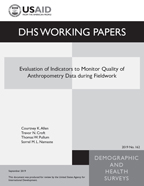
Abstract:
Background: High-quality data on stunting
(height-for-age (HAZ) < -2SD) and wasting
(weight-for-height (WHZ) < -2SD) are critical
to inform country and global decision-making
on nutrition policy and programming. Yet,
anthropometry assessment in field settings
remains a challenge, and tools are needed to
improve data collection. We sought to
evaluate the capability of anthropometric
data quality indicators to assess survey
teams’ performance during fieldwork.
Methods: A total of 26 data quality
indicators were identified for height,
weight, and date of birth data. Two target
levels for each indicator were established by
taking the lowest 25th and median of 147
Demographic and Health Survey (DHS) surveys.
We applied the indicators to six recent DHS
surveys. Data quality indicators were
summarized, and Pearson’s correlation
coefficients were calculated between teams
using cumulative data across the survey
period. Patterns of performance over time
were examined by calculating the quarterly
HAZ implausible values and standard
deviations by team. Principal component
factor analysis (PCA) was used to generate a
composite anthropometry data quality score in
order to rank each team’s performance.
Results: Thirteen of the 26 data quality
indicators were retained, with those related
to HAZ and WHZ z-scores being particularly
useful. There was a wide range in the teams’
implausible HAZ and WHZ anthropometry z-
scores (HAZ: range 0-17%, WHZ: 0-19%) and
standard deviations (HAZ: range 0.97-2.54,
WHZ: 0.94-2.35) across surveys. These
indicators also tended to contribute the
greatest to the PCA factor loading for the
PCA using height and weight indicators in the
four lowest-performing surveys (ranging from
0.28 to 0.49 for HAZ implausible, 0.35 to
0.47 for WHZ implausible, 0.25 to 0.43 for
HAZ SD, and 0.13 to 0.37 for WHZ SD). The HAZ
interval, used to capture date of birth
quality, showed some teams achieving the
expected near-zero HAZ z-score, but reached
as high as a z-score of 1.86. There were
inconsistent factor loadings across surveys
for the PCA that used date of birth
indicators. The targets we constructed based
on the median performance of 147 surveys were
0.7% for HAZ implausible, 1.6%, for WHZ
implausible, 1.59 for HAZ SD, 1.30 for WHZ
SD, and 0.25 for HAZ interval. There was no
clear pattern in improvements or degeneration
as fieldwork progressed based on HAZ
implausible values and HAZ SD.
Conclusion: In the present study, we found
anthropometry data quality indicators can be
used to detect poorly performing teams during
fieldwork. Further research should link data
quality indicators to the outcomes of
interest (stunting and wasting) to enhance
monitoring practices.
 Evaluation of Indicators to Monitor Quality of Anthropometry Data during Fieldwork (PDF, 1011K)
Evaluation of Indicators to Monitor Quality of Anthropometry Data during Fieldwork (PDF, 1011K)
